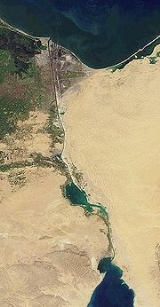
1854 In Egypt, the Suez Canal, linking the Mediterranean Sea with the Red Sea, is given the necessary royal concession.
1859 British and French engineers break ground for the Suez Canal.
1867 The first ship passes through the Suez Canal.
1869 In Egypt, the Suez Canal, linking the Mediterranean Sea with the Red Sea, is inaugurated.
1888 The Convention of Constantinople is signed, guaranteeing free maritime passage through the Suez Canal during war and peace.
1956 Following the World Bank's refusal to fund building the Aswan High Dam, Egyptian leader Gamal Abdel Nasser nationalizes the Suez Canal sparking international condemnation.
1956 Suez Crisis begins: Israeli forces invade the Sinai Peninsula and push Egyptian forces back toward the Suez Canal.
1956 Suez Crisis: The United Kingdom and France begin bombing Egypt to force the reopening of the Suez Canal.
1957 Egypt re-opens the Suez Canal after the Suez Crisis.
1957 The Suez Canal in Egypt is cleared and opens to shipping.
1957 The Suez Canal is reopened for all shipping after being closed for three months.
1957 Suez Crisis: The Suez Canal is reopened following the introduction of UNEF peacekeepers to the region.
1973 Yom Kippur War: Gabi Amir's armored brigade attacks Egyptian occupied positions on the Israeli side of the Suez Canal, in hope of driving them away. The attack fails, and over 150 Israeli tanks are destroyed.
1974 The last Israeli soldiers leave the west bank of the Suez Canal pursuant to a truce with Egypt.
1974 Yom Kippur War: Israeli forces withdraw from the west bank of the Suez Canal.
1975 The Suez Canal opens for the first time since the Six-Day War.
1986 The United States Navy aircraft carrier {{USS|Enterprise|CVN-65|6}} becomes the first nuclear-powered aircraft carrier to transit the Suez Canal, navigating from the Red Sea to the Mediterranean Sea to relieve the {{USS|Coral Sea|CV-43|6}}.
2006 The French warship Clemenceau reaches Egypt and is barred access to the Suez Canal. Greenpeace activists board the ship.

